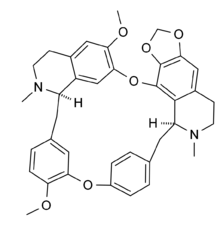Cepharanthine
Cepharanthine is an antiinflammatory and antineoplastic compound isolated from Stephania.[1] Due to these modalities, it has been shown effective against HTLV in lab research. [2] Additionally, it has successfully been used to treat a diverse range of medical conditions, including radiation-induced leukopenia, idiopathic thrombocytopenic purpura, alopecia areata, alopecia pityrodes, venomous snakebites, xerostomia, sarcoidosis, refractory anemia and various cancer-related conditions. No safety issues have been observed with CEP, and side effects are very rarely reported. [3]
 | |
| Clinical data | |
|---|---|
| Other names | Cepharantin, O-Methylcepharanoline |
| AHFS/Drugs.com | International Drug Names |
| ATC code |
|
| Identifiers | |
| PubChem CID | |
| ChemSpider | |
| ChEMBL | |
| CompTox Dashboard (EPA) | |
| ECHA InfoCard | 100.208.632 |
| Chemical and physical data | |
| Formula | C37H38N2O6 |
| Molar mass | 606.70742 g/mol g·mol−1 |
| 3D model (JSmol) | |
SMILES
| |
InChI
| |
References
- Huang, H.; Hu, G.; Wang, C.; Xu, H.; Chen, X.; Qian, A. (2013). "Cepharanthine, an Alkaloid from Stephania cepharantha Hayata, Inhibits the Inflammatory Response in the RAW264.7 Cell and Mouse Models". Inflammation. 37 (1): 235–46. doi:10.1007/s10753-013-9734-8. PMID 24045962.
- Toyama, M; Hamasaki, T; Uto, T; Aoyama, H; Okamoto, M; Hashmoto, Y; Baba, M (2012). "Synergistic inhibition of HTLV-1-infected cell proliferation by combination of cepharanthine and a tetramethylnaphthalene derivative". Anticancer Res. 32: 2639–45. PMID 22753721.
- Rogosnitzky, M; Danks, R. "Therapeutic potential of the biscoclaurine alkaloid, cepharanthine, for a range of clinical conditions". Pharmacol Rep. 63: 337–47. PMID 21602589.
This article is issued from
Wikipedia.
The text is licensed under Creative
Commons - Attribution - Sharealike.
Additional terms may apply for the media files.